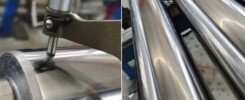As a specialized manufacturer with over 20 years of expertise in cold drawn seamless steel tubing, we bridge the gap between raw material potential and industrial-grade reliability. This article dives into the technical nuances of 20MnV6 cold drawn tube production, highlighting our proprietary processes and competitive edge in delivering premium solutions.
The Material Advantage Of 20MnV6 cold drawn tube
Before exploring production, it’s critical to understand why 20MnV6 is the go-to alloy for high-strength seamless tubes.
Chemical Composition & Mechanical Properties
20MnV6 is a low-alloy high-strength steel (HSLA) with:
- Carbon (C): 0.17–0.23% (balances strength and formability).
- Manganese (Mn): 1.30–1.60% (enhances hardenability and toughness).
- Vanadium (V): 0.15–0.25% (microalloying element for grain refinement and precipitation strengthening).
Key Mechanical Properties:
- Tensile Strength: 600–750 MPa (superior to standard 20# steel).
- Yield Strength: ≥450 MPa (ideal for high-pressure applications).
- Elongation: ≥16% (ensures formability during machining).
The Science of 20MnV6 Cold Drawn Seamless Tube Production
Cold drawing is far more than just pulling metal through a die. It’s a precision process that transforms raw steel into a dimensionally accurate, high-performance tube. Here’s how we optimize each stage:
1. Raw Material Selection: The Foundation of Quality
We source 20MnV6 steel billets/slabs from certified suppliers with strict chemical composition controls (±0.02% tolerance for key elements like Mn and V). Each billet undergoes ultrasonic testing (UT) to detect internal defects before entering production.
2. Preprocessing: Heating & Piercing
Heating: Billets are heated to 1150–1200°C in a walking-beam furnace with precise temperature zoning (±10°C control). This ensures uniform austenitization without overheating, which could degrade mechanical properties.
Piercing: Using a rotary piercing mill, we create a hollow shell (bloom) from the heated billet. Our 5-roll piercing machine minimizes wall thickness deviation (≤0.1mm) and ensures smooth inner surfaces.
3. Cold Drawing: Precision Shaping
Cold drawing is where 20MnV6’s work hardening potential is harnessed. We use a two-stage process:
First Pass: The bloom is drawn through a carbide die with a reduction ratio of 20–25%. This initial pass establishes the tube’s outer diameter (OD) and wall thickness (WT).
Subsequent Passes: For tighter tolerances (e.g., OD ±0.1mm, WT ±5% of nominal), we use diamond or ceramic-coated dies. Our multi-pass drawing lines incorporate intermediate annealing (in a continuous mesh belt furnace at 750–800°C) to relieve stress and restore ductility, preventing cracking.
20MnV6 cold drawn seamless tubes are more than just metal—they’re the backbone of reliable, high-performance industrial components. At our factory, we combine cutting-edge production technology, rigorous quality control, and deep material expertise to deliver tubes that exceed industry standards. Whether you need standard sizes or custom-engineered solutions, we’re committed to providing 20MnV6 tubes that perform when it matters most.

